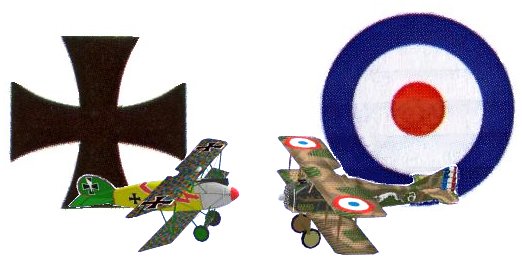
Aerial Maneuvers
(cont.)
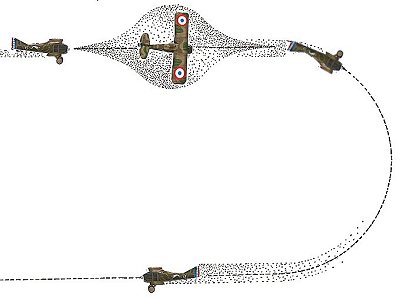
A useful maneuver for pilots was the Half Roll with the Split-S. Actually called the Renversement in the early days of avaiation, the main objective of this maneuver was to change direction 180 degrees. To perform this maneuver, the pilot would roll on the axis of the plane. However, this was easier said than done, as early WW I machines tended to drop the nose at the moment of the roll. Therefore, this maneuver often resembled something closer to a half snap roll with the split-S (see below). The prime advantage of this maneuver was that the pilot would not bleed off much speed before making the split-S. Excellent for quickly reversing direction in combat.
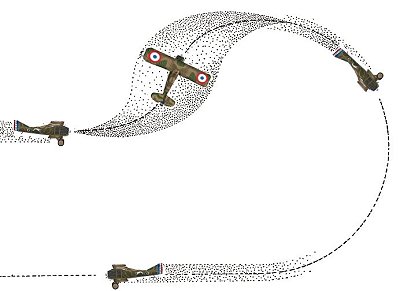
Similar to the half roll with the split-S was the Half Snap Roll with the Split-S. This maneuver has a significant difference. By putting a Snap Roll in the maneuver, the pilot bleeds off significant speed. If an enemy machine is close on his tail, this will force the following plane to maneuver to avoid a collision. Then, the split-S which follows can completely shake the opponent. The danger in the maneuver is that for a brief moment the pilot may hang his plane in the air, making it an excellent target for an enemy. The maneuver is performed by combining rudder and aileron moments at the same time. As a result, the plane will snap up and at an angle, commencing to roll at the height of the snap. After that, complete the split-S as usual. In modern parllance, this entire maneuver is the true split-S.
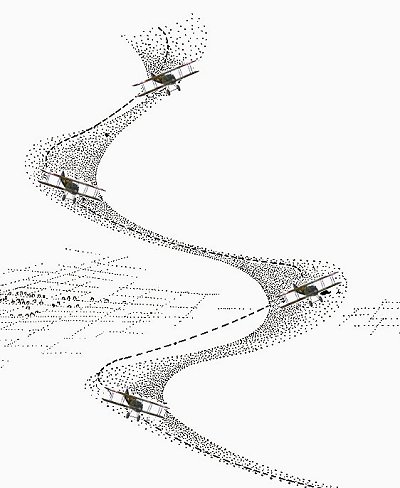
There would be pilots who would try and convince others that using deception to fool an enemy that you were dead was useless, yet many of these same pilots would resort to spins and other tricks to deceive an enemy. One of these techniques was the
Falling Leaf. In this maneuver, the pilot brings the plane to the point of a stall by pulling up the nose and throttling back some. As the plane stalls, it begins to loose lift, causing it to lose altitude. Concurrently, the pilot can side slip, causing air to spill out from beneath the wings and accelerating the fall. By doing this side to side he can actually control the descent, and hence give this maneuver its apt name.
Falling Leaf. In this maneuver, the pilot brings the plane to the point of a stall by pulling up the nose and throttling back some. As the plane stalls, it begins to loose lift, causing it to lose altitude. Concurrently, the pilot can side slip, causing air to spill out from beneath the wings and accelerating the fall. By doing this side to side he can actually control the descent, and hence give this maneuver its apt name.
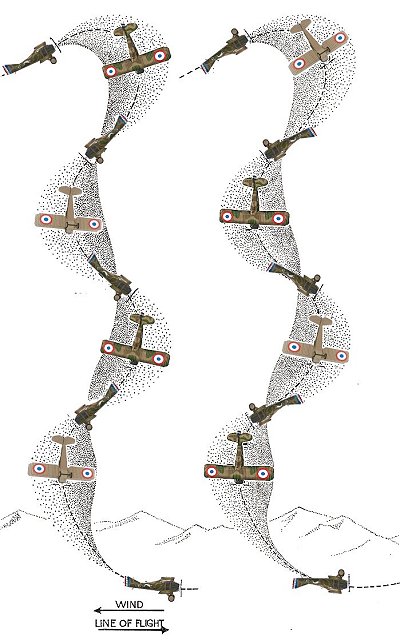
The Spin was initially an infamous maneuver that was indicative that you lost control of your aircraft. Typically, when a spin develops, the pilot's instinctive reaction is to pull up the nose. This only intensifies the spinning moment and the pilot soon loses his orientation and his machine crashes. Once pilots figured it out, the spin actually became a useful maneuver on occasion. The secret was to push the nose down when the plane began to spin. This provided lift and thrust, allowing the pilot to regain control after several revolutions. However, it was crucial to have altitude before doing this maneuver. Otherwise, one will spin into the ground (called "spinning in").
The spin could be useful when trying to convince an enemy you were dead. It can even be used in flight simulators with effect, especially in a target rich environment. The more effective version is the
Inverted Spin which involves performing the maneuver while the plane is on its back! It is not easy, but if you master it, you may just convince an opponent that you're finished an going in. Roll the plane until it is inverted, and then push forward on the stick, raising the nose. As the plane approaches the stall, kick the rudder and hold it, using ailerons to keep the machine from rolling over. The spin will develop, more quickly in unstable machines, and then it is a matter of maintaining attitude during the spinning moment. As can be seen, this maneuver requires serious practice.
Inverted Spin which involves performing the maneuver while the plane is on its back! It is not easy, but if you master it, you may just convince an opponent that you're finished an going in. Roll the plane until it is inverted, and then push forward on the stick, raising the nose. As the plane approaches the stall, kick the rudder and hold it, using ailerons to keep the machine from rolling over. The spin will develop, more quickly in unstable machines, and then it is a matter of maintaining attitude during the spinning moment. As can be seen, this maneuver requires serious practice.